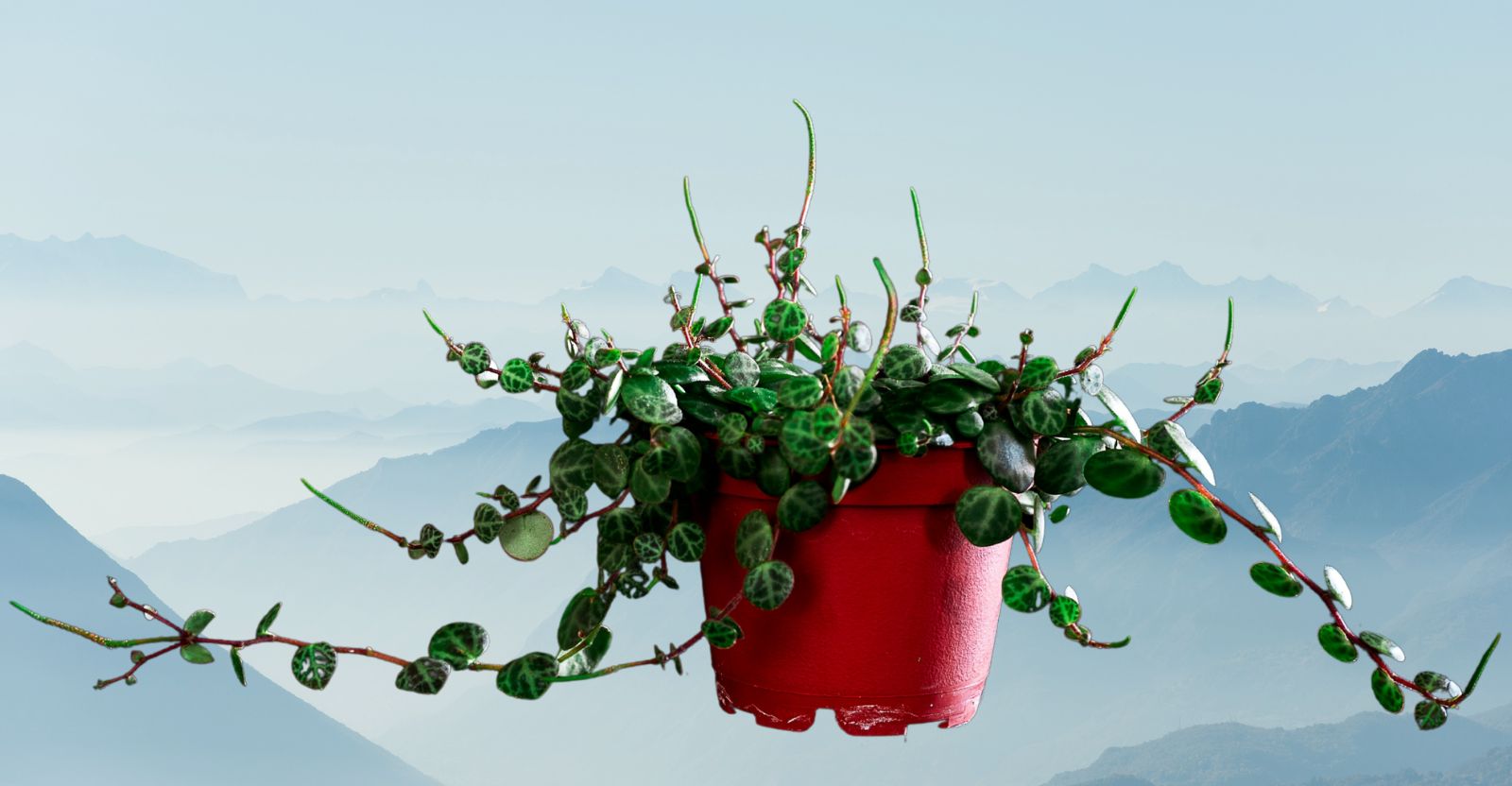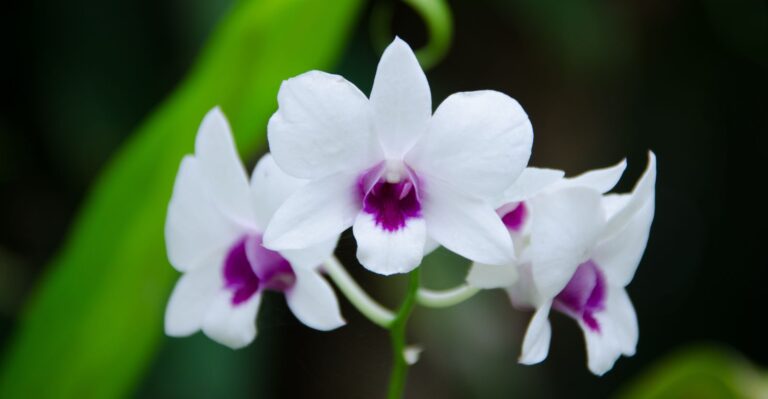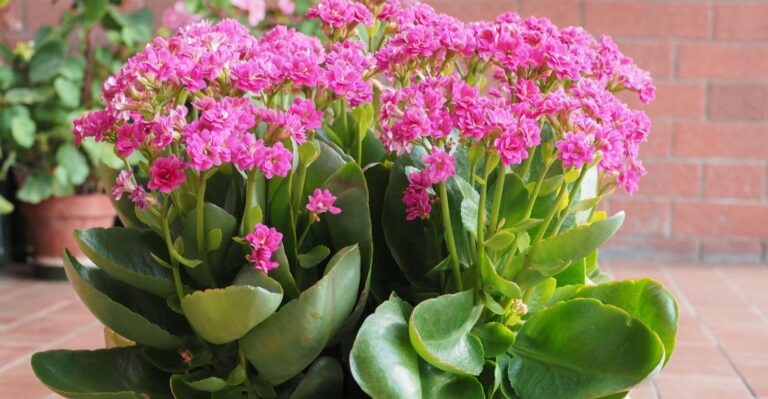Amazon has put together some great Home Gift Deals – save money and get your shopping done at the comfort of your home! Click here to see deals on Amazon
Peperomia prostrata is the Piperaceae family of plants, a tropical plant native to the rainforests of Ecuador and Costa Rica.
They’re vines, usually climbing up on other plants and trellises. It’s also known as the String of Pearls, Jade Necklace, String of Turtles, and a String of Hearts.
It’s a slow-growing popular plant that grows well in moist soil. The pattern on the leaves appears like a turtle shell making it a great indoor houseplant. It’s an excellent choice to grow indoor or outdoor in hanging baskets, containers, terrariums, or climb it on a trellis.
You can also grow it in an outdoor container, although they do best on a windowsill. Planting peperomia prostrata is a great way to add some greenery to your home or office.
This guide covers everything you need to know to grow and care for this beautiful plant.
Let’s get started.
Why should you plant Peperomia prostrata?
You should plant it because it’s not only easy to grow, but it also can take abuse and neglect that would kill other houseplants. In the wild, it’s an epiphytic plant, which means it doesn’t grow in water or soil, instead, it grows in cracks of stones or on decaying logs.
The small plant heights can grow up to 1 foot tall and usually matures between 3 and 5 years. It has very distinct glossy leaves, which are dark green and mottled with a pattern of silver and gold.
The beautiful patterns on a small string of leaves with white veins change color as it matures. Some people also consider it to be a semi-succulent plant, but it’s a tropical perennial plant.
It has rosette succulent-type leaves with tiny spines along the edges of its leaves. Although it’s a perennial, it’s best grown as an annual in temperate regions. It’s an excellent choice for people who want a lowlight or no-light houseplant.
| Factor | Growth Condition |
|---|---|
| Soil | Well-drained sandy soil |
| Water | Once every 2 – 3 weeks |
| Sunlight | Indirect partial sunlight |
| Temperature | 64 °F to 75 °F (18 °C – 24° C). |
| Fertilizer | Slow release or diluted liquid fertilizer |
| Propagation | Stem or leaf cutting |
| USDA Zone | 10 – 12 |
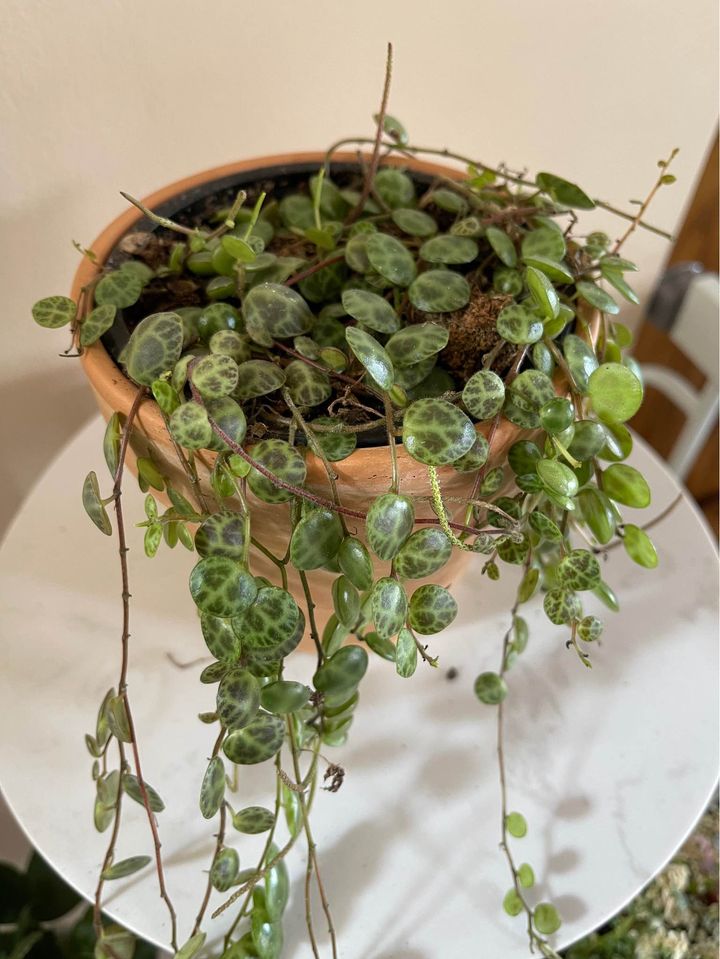
How to care for peperomia prostrata (string of pearls)?
Caring for a string of pearls plant isn’t difficult as long as you follow a few simple rules:
What type of soil strings of pearls need?
It prefers soil that has good drainage and will grow best in well-drained organic soil with sand. This means you can prepare loamy soil with a mixture of compost and peat moss for healthy new growth. While it appears like a succulent, you shouldn’t use a potting mix sold exclusively for succulents.
If you find your peperomia isn’t growing well, the problem may be that the soil isn’t acidic enough for it. It prefers fertile potting soil that is acidic, with pH levels of 5.5 to 6, which is more acidic than the soil in most yards.
If you’re growing it in the outdoor ground, you can amend the soil by applying powdered sulfur to the soil. You should have already amended the soil with compost, or another source of organic material, to condition the soil before planting.
To allow air to pass through to its root, you should keep the soil loose. You can add perlite and peat moss in a 1:2 ratio to properly aerate and retain moisture in the ground.
If you have bought the plant online and it comes in tiny pot size, you may have to repot it. This is because as the plant grows, it needs more room to spread its leaves. Eventually, the plant gets so large that it can’t stay in its pot any longer.
Repotting it in a larger container is often a good choice. But you don’t have to do it right away. It’s generally a good idea to wait until your peperomia is at least one year old before repotting. Then, choose a shallow pot to prevent any waterlogging to its roots for optimal peperomia prostrata care.
Read More: Best Potting Soil for Indoor and Outdoor Garden
How much water does peperomia need?
Peperomia doesn’t need much water. If you don’t live in a sweltering climate, usually watering it once every one to two weeks is enough. However, its root is susceptible to overwatering and easily rotten if it remains saturated with water for long.
The excess water causes the plant to start shedding its leaves due to root rot while permanently damaging plant growth. Therefore, proper watering is key to the long-term health of any peperomia.
If you’re unsure whether it needs water, check the top dry soil by inserting your finger in it. If the finger remains dry, you can keep the soil moist by watering it; otherwise, wait for a few more days.
When planted indoors, the most common mistake made by the Peperomia owner is overwatering, which causes mold growth on soggy soil.
You can apply insecticidal soap or neem oil as a preventive spray on green foliage to treat molds. But you should also be wary of underwatering as it may cause wilted or flat leave and dead foliage. You can buy neem oil (Amazon link) and insecticidal soap (Amazon link) to get started.
You can do more frequent watering during spring and summer when the climate is hot and the plant grows fast. Slow down during the winter months and water it once every two to three weeks.
How much light does a peperomia plant need
People’s most common question when they’re growing peperomia plant is about how much bright light does it need. Currently, there is no such thing as a set number of hours of sunlight that it needs to thrive. But there is a general standard for how much sunlight to give them.
Even though it’s not a demanding plant and isn’t fussy about light levels, it doesn’t like the temperature to be below 50°F (10°C).
So you shouldn’t expose it to direct harsh sunlight but place it where it can get indirect 7 to 8 hours of daylight. If you don’t have natural light in your room, you can put it under artificial light.
Placing it near the north or south-facing indirect but strong sunlight window or at the desk shelf where it can get regular indirect light is enough for its healthy growth. Try to maintain the indoor room temperature between 64°F to 75°F (18°C—24°C).
As it’s native to South America and Africa, the plant can be grown as an indoor or outdoor plant in the U.S. Department of Agriculture plant hardiness zones 10 through 12.
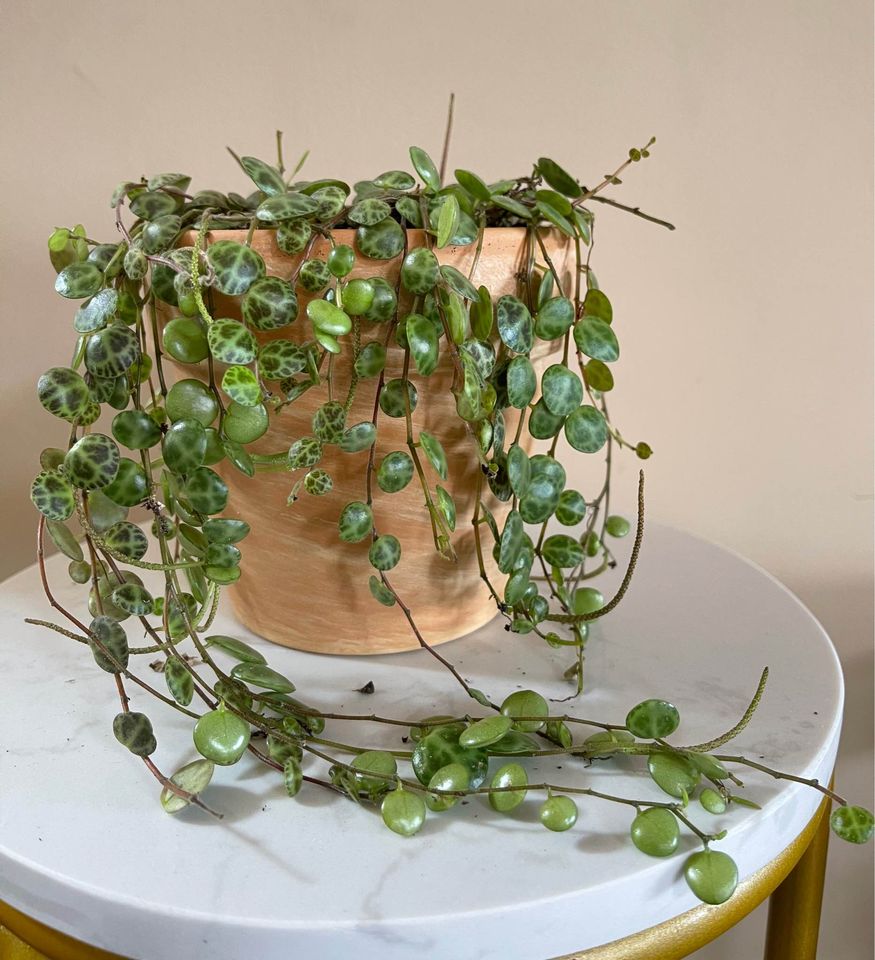
How to fertilize String of pearls
The most common fertilization method uses a slow-release fertilizer, which you release into the water about once a month. Another option is to use a semi-diluted liquid fertilizer every two to three weeks in the growing summer season. You don’t need to fertilize it from autumn to spring.
Using a well-balanced 10-10-10 fertilizer works best. You don’t need to use too much fertilizer to make it grow healthy. If the soil contains enough organic compost and other nutrients, you can get away without fertilizing it. We found American Green all-purpose fertilizer to work great that you can buy it from Amazon.
Note:
For proper plant care, too much fertilizer often causes the plant to start dropping leaves.
Do you need to prune string of pearls plant?
Pruning it at regular intervals helps control the growth and spread of the plant. Trimming excessively grown plants give it an appealing shape and neater bushy appearance while keeping the spread of the plant under control.
As many people like to grow it as an indoor plant, the unkempt and leggy appearance of the plant makes it unsightly. However, there are a few different ways you can go about pruning the string of pearls.
The best option is to use a sterilized pair of scissors or pruning shear and remove the overgrown stem or yellow leaves. Pay particular attention to removing dead and damaged leaves and stems.
Removing these and unwanted growth helps the plant to grow bushier. In addition, you should move healthy plants away from an infected plant and remove the disease’s part to stop the infection spread.
Do peperomia like to be misted?
Peperomia’s thick waxy leaves and lowlight requirements make them a favorite for people with black thumbs. But do peperomia like to be misted?
Some experts say it won’t need to be misted, while others say the delicate leaves are prone to drying out if not misted.
When you compare it to other plants, it prefers a slightly moist and humid environment. So yes, misting leaves with a fine spray of water during drier months allows the leaves to retain moisture. It grows best in high humidity levels between 60% -90%.
Regular misting also wash away dust, pollen, and other airborne pollutants while providing the required moisture to plant leaves. It also prevents peperomia leaves from becoming too dry or too wet, resulting in leaf drop or foliage discoloration.
How to propagate the string of turtles (Peperomia)?
Stem and leaf-cutting are the two popular ways to propagate Peperomia. The stem or vine cuttings are a relatively easy propagation process, as long as you follow a few precautions.
First, find the healthy stem of the plant that is either a few inches long or has at least one healthy node. Then, using a sharp knife, cut about one to two inches deep in the stem with leaves.
Ensure that it has a couple of leaves left on the stem. You can also apply rooting hormone to encourage fast growth, but it’s optional.
Next, insert the cutting in a moist but not overly watered potting mix. Place it in a bright location where it can receive a couple of hours of indirect sunlight.
Maintain the optimal indoor temperature to encourage the new stem to start growing roots from its node. It may take anywhere from 6 to 8 weeks for the roots to be strong enough to sustain the new plant.
You can also propagate it through leaf cutting, but it usually requires a longer wait time and a more careful approach. In addition, you should provide it adequate moisture and sunlight for optimal growth.
Does peperomia prostrata have flowers?
Yes, peperomia prostrata have flowers that look like a spike. But these vining plants are mainly grown for their decorative variegated leaves. Some varieties have leaves that are decorated with exciting color markings.
The plant rarely flowers in the wild, though some grower varieties produce flowers with white or dark red petals with a beautiful pattern of dark blue to white veins. Unfortunately, the flowers aren’t very noticeable since they’re small and have a brief lifespan.

Why do peperomia prostrata turn yellow?
If you’re noticing your peperomia turning yellow, this happens for several reasons. The most common reasons are too much direct sunlight, overwatering, or not enough nutrients. The good news is that it’s easy to fix and won’t affect the plant’s health.
For most people, when they have planted it indoors, overwatering is the common culprit. The plant should go through a period of dry ground between the watering schedule. It helps the roots get dry and not always saturated with water that may cause the wilted or discolored foliage.
The water sitting at the top layer of soil causes the roots to begin to rot, weakening the plant. This results in the succulent leaves slowly turning yellow and eventually falling off. If you found the soil to be soggy and the plant foliage has a weak grip on the ground, stop watering it anymore.
Allow the soil to get dry and check if the condition improves. You may have to repot if the ground condition doesn’t improve. Also, place the plant at a different location if it gets exposed to direct sunlight.
Finally, check for any common pests such as whiteflies, mealybugs, or spider mites spreading on the fragile stems or ornamental leaves. Use insecticides or manually remove these pests from the plant.
Is peperomia prostrata toxic to cats?
Peperomia prostrata is toxic to cats and other pets if they chew its leaves in a large quantity. The peperomia is poisonous because it contains calcium oxalate crystals, which are harmful.
The symptoms of exposure can include respiratory irritation, vomiting, and diarrhea. If you think that your pet may have been exposed, take appropriate actions to remove the plant from the area and consult a veterinarian.
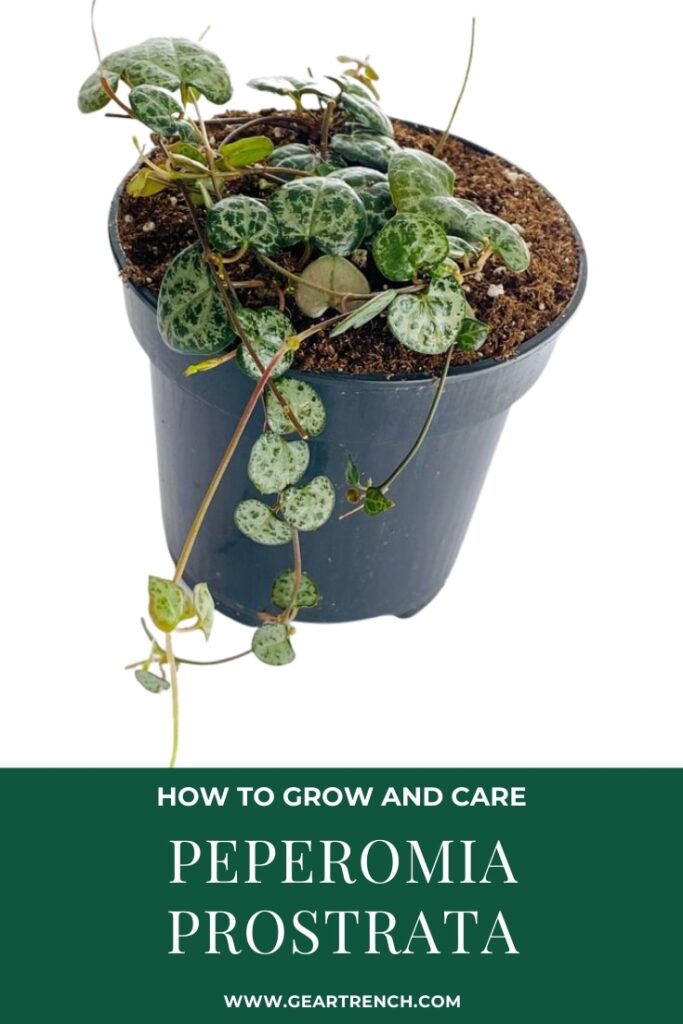
Don’t forget to share this post

